Friday July 26, 2013
Site 730, Narrows Too
Trenton, Maine
It starts raining Thursday afternoon and rains steadily for the next 24 hours.
Looking pretty dreary when we get up. Nice day for the ducks.
So what to do in the rain? We’ve been wanting to see the Abbe Museum and this is just the right day.
I suspect a lot of other people will have this same idea but what the heck.
The Abbe is in Bar Harbor and was much closer to us while we were at Blackwoods. Today it is a 12 mile drive. But we head in to town to take a look.
This is the “new” additional Abbe location in downtown Bar Harbor. The oldest part of the building facing Mount Dessert street was built in the early 1890’s. it served as the YMCA for more than 100 years.
The Abbe was founded at its Sieur de Monts location in 1926 by Dr. Robert Abbe an eminent New York physician known for his pioneering work in radiation therapy.
He was a summer resident of Bar Harbor and during the 1920’s assembled a collection of early Native American artifacts. He and other amateur archeologists of the island established the museum to protect the objects and display them to the public.
In 1928 the Abbe became the first institution in Maine to sponsor archeological research which it continues today. It is the main repository for archeological collections from the midcoast Maine region.
It expanded its scope to include ethnographic materials from the 17th through the 20th century and has acquired an extensive contemporary collection documenting the continuing Wabanaki craft tradition in Maine. The Abbe’s collections now represent 10,000 years of Native American culture and history in Maine. It holds the largest and best documented collection of Maine Indian basketry.
By the 1990s the Abbe's 2,000-square-foot museum at Sieur de Monts Spring had become inadequate to house the growing collections, and provided no space for indoor programs, changing exhibitions or research. Because of its location it could only operate seasonally. In 1997, the Abbe purchased the former YMCA building in downtown Bar Harbor. A $6 million capital campaign enabled the Abbe to renovate and expand the 1893 landmark to create a 17,000-square-foot museum with exhibition galleries, indoor and outdoor program spaces, a research lab and state-of-the-art collections storage.
There is a lot to see here as you can tell from the floor map.
The Abbe Bar Harbor is eight times the size of the original Abbe. The total collection includes more than 50,000 items spanning 10,000 years.
The Downtown Abbe museum opened on September 29, 2001 and has permanent and changing exhibitions including the major installation of “Wabanaki: People of the Dawn” which we view today.
We begin in the Orientation Gallery on the left opposite the museum shop as you enter the museum. It includes an extensive time line of the Wabanaki people with world events listed above along the time line for reference. The time line is shown below. It is what David is reading in the above picture.
This time line is unique at least for me in that it begins with contemporary events and works backwards in the Wabanaki history. I had no idea that Native Americans were only given the right to vote in National Elections in 1954. It was 1967 before they were allowed to vote in Maine State Elections.
Also in this Gallery today is an etching activity to give visitors a chance to see how the Wabanaki etch designs on birch bark baskets and canoes. The people at the tables are working on this. Birch trees have a winter and a summer bark. The winter bark is on the trees at the time of sap rising and is the dark color of the basket (the inside of the bark). Thus if they etch off the darker color they expose the lighter color and thus by using the lighter color negative space they can reveal their etching. They sometimes do this same artistic rendering on their canoes.
The art work is outstanding.
Also in the Orientation Gallery today is a model of building a canoe.
Raney Bench, the Curator of Education, explains the entire process to us which is mind boggling. Two master builders would build a 20’ birch bark canoe from the selection of the tree, stripping the bark, building the frame to the finished product. She answers every question and clearly knows the process thoroughly. She also tells us that in early August they will be having 2 master builders actually building a canoe in the outdoor courtyard. I want to come back and see that. If you are in the area, I hope you will come too. You’ll be amazed.
It is hard for me to get out of the Orientation Gallery, there is so much to see. But there is so much more in the museum that I have to move along. Only one more thing….the story book in Passamaquoddy and English. I read the entire story of Espons and really enjoy trying to pronounce the Native words. Espons is quite a rascal.
So who are the Wabanaki people?
Raney explains to us that the Wabanaki Tribes of Maine are a group of 4 tribes has been a confederacy since prior to the white settlement of Maine. The four federally recognized tribes are the Maliseet, Micmac, Penobscot and Passamaquoddy. Each tribe maintains its own tribal government, community schools, cultural centers and manages tribal lands and natural resources. The Aroostook Band of Micmac live in Presque Isle.
The Houlton Band of Maliseet live in Houlton. The Passamaquoddy Tribe have two reservations at Indian Township and Pleasant Point. The Penobscot Indian Nation has their main reservation at Indian Island.
Today the Education Gallery has two types of education going on.
Like the activities in the Orientation Gallery, all the Abbe exhibitions are accompanied by a variety of educational programs for adults and families. They also present special programs for school groups. Today there is one on basket weaving taking place in the Education Gallery.
There is also an exhibit on the walls discussing the central Wabanaki homeland area which was over the years used as a toxic waste dump by federal contractors. In the 1990’s it became a superfund site and the clean up led to an ongoing archeological project documenting the Native Presence in this area for over 12,000 years.
As we continue on, we learn about other Wabanaki crafts.
In the hallway between these two rooms the time line continues. We also learn about other skills perfected into artistic crafts by the Wabanaki. These talking stick carvings on the wall are exquisite. The detail is amazing.
The Wabanaki make several types of baskets including sweetgrass. I am surprised to see this as I know that many Native peoples weave sweetgrass baskets along the coastal south. I wasn’t expecting to find sweetgrass this far north. I find the explanation of the process for gathering sweetgrass very interesting. The patience and attention to detail that goes into all of these arts is a tradition the Native peoples seem to be keeping alive. I have great admiration for them.
Over the years the Abbe has changed its focus from collecting to collaboration.
The Abbe began its collaboration with Native people during the 1980’s and 90’s and has had exhibitions on many local artists such as the birchbark art of Tomah Joseph. During recent years Native Americans have become involved in all aspects of the museum as members of the Board of Trustees.
The current exhibition on the Wabanaki Guides is perfect for me. I first read about them during my “Thoreau period” and had completely forgotten.

The Exhibition Gallery today is devoted to another of the Wabanaki skills. They are renown for their basketry, canoe building, carving skills and for providing expert guiding services for nearly 200 years. I had no idea the long tradition of Naive Maine Guides.
Explorers, cartographers, artists, hunters, and writers have all employed the Wabanaki as guides, learning how to travel, hunt, appreciate and live in what is now called Maine amid the rugged beauty, rocky coastlines and extreme tides where dense forests, rivers and lakes dominate the landscape interspersed with mountains and rocky terrain. Weather can change suddenly. The ancestors of the Wabanaki have lived here for over 12,000 years. Visitors to Maine continue to hire Wabanaki guides for these same reasons.
Here’s where Henry David comes in and the light goes off in my head.
This exhibit talks about the history of the Guides, showing many examples of historical trips and guides along with quotations from those who went hunting or fishing by birch bark canoe into the interior of Maine with them. Anyone who has read Henry David Thoreau’s book The Maine Woods (1864) has read about his trips with Wabanaki Guides.
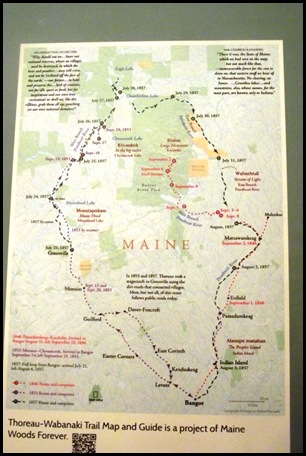
This is a map of the new Thoreau-Wabanaki trail formed by stitching Thoreau’s trips together into a 30 miles paddle. Thoreau took three trips. One in 1846, 1853, and 1857. The 1853 trip was with Wabanaki guide Joseph Attean and the 1857 with Wabanaki guide Joe Polis. There has been a book written about traveling the new trail entitled Wilderness Within, Wilderness Without: Exploring Maine’s Thoreau- Wabanaki Trail. Sounds like a great trip I’d love to do.
The guides use birch bark cones to call the moose. Notice the beautiful carvings on the cone. They imitate a female moose call to attract the male. When the moose calls back, they make the female call sound a long way off so that the moose will come right by them on his way to the female. Apparently they were amazingly successful with this trick. Poor moose.
The exhibit has a sample “camp” set up with a moose hide skin for a blanket inside the tent. I had no idea moose fur was 5 or 6” long. It felt much different than any other fur I’ve ever felt.
Throughout the exhibit they emphasize the ongoing nature of the Wabanaki Guides training and the certifying of new guides. I am particularly impressed that Jennifer Neptune is a Penobscot Indian guide in training who will have to pass rigorous tests to be licensed to guide. She is keeping the tradition alive in her family.
And now for the quiz.
As part of the educational information regarding the Wabanaki Guides exhibit there is a Tracking challenge in which you look at the footprints, scat and habitat of an animal and try to identify it..
There are 9 and I am only able to get 4. Not a very good percentage but I learn a lot.
I do a lot better on the “what would you do quiz”. They show you a scenario that has happened to a guide and give you three possible ways to respond. You are to pick the correct one. I get them all right so now David thinks I should sign up to be a guide. Hmmmm, one big problem, I’m not a Wabanaki.
Both of the educational “quizzes” are a lot of fun and very educational.
The last thing I’ll show from this Gallery is a beautiful work of art in the form of a hand made snowshoe. It looks like intricate crochet work to me. These are Penobscot snowshoes made of ash or birch and hide. They are said to be almost identical to a pair Thoreau owned that date to 1853..
The Abbe Bar Harbor serves the community year round, while the trailside Abbe at Sieur de Monts Spring is open seasonally. In a previous post I showed a picture of us having lunch one afternoon in front of the original Abbe at Sieur de Monts. We will definitely use our ticket and return there to see the original museum.
This is the very best place to learn about the Native peoples of Maine, their history, their beautiful craftsmanship, their sense of place and love for their home lands and their ongoing position in the communities of Maine.
We spend the entire day here and enjoy it immensely. Admission is $6 ($5 for seniors) and includes admission to both museums.
I’ll leave you with some of the magnificent basketry for sale in the museum store.
This set of nesting baskets has birch bark folded butterflies on the lids.
Ok school’s out and it is time to PARTY.
We get back from the Abbe in time to whip up a fresh fruit salad to take to the potluck party for Gin’s 50th birthday. She’s joined the half century club. Doesn’t she look it? Party hat, noise maker and all??HA!
Everybody brings a little something for the dinner and all the cooks are getting it set up.
Not sure if Nancy is first in line but I know I’m not far behind her.
This is some delicious food!! Lasagna, two kinds of salad, garlic bread and the birthday cake is a cheese cake. Whoever planned the menu gets an A+!!
Good thing Gin and Syl have the party house since it was originally planned to be outside but then it rained ALL DAY LONG!
And here we are, the youngest and the oldest on either side of the birthday girl. Don’t we look like the 3 musketeers or is that mouseketeers?? Are these girls too young to even know who Annette was?? :-))
These folks definitely know how to throw a party.
Happy happy birthday GIN and many many more!!





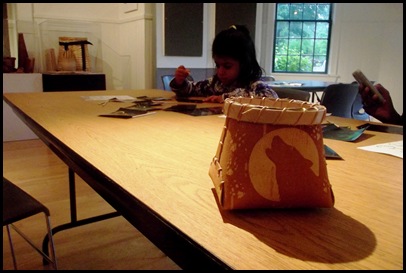
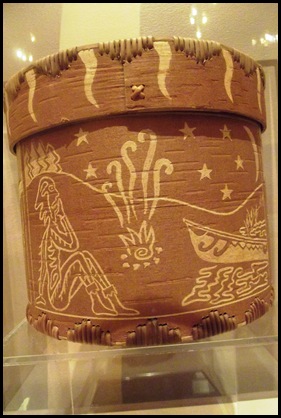

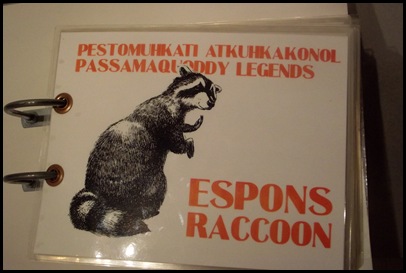




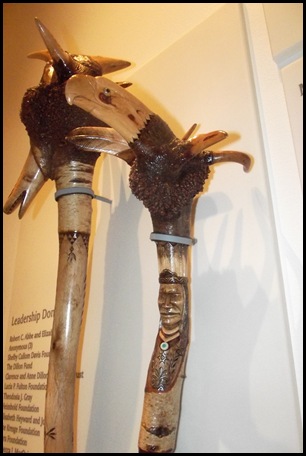













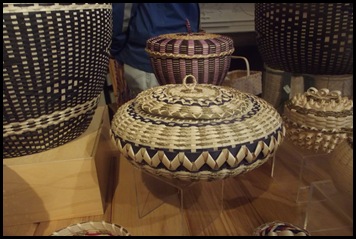



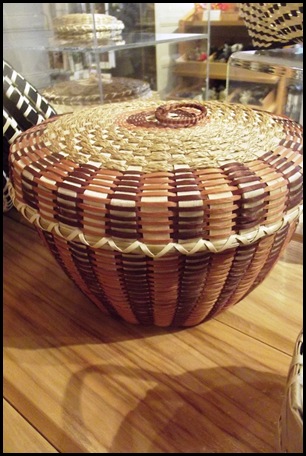





That museum looks like a must do next time we travel in those parts.
ReplyDeleteThanks for the pictures!
What an interesting museum. Love the detail in the baskets and snowshoe. Looks like everyone had fun celebrating Gin's birthday!
ReplyDeleteWhat a fantastic museum. Love the native arts. Those baskets are spectacular. Surely you didn't see the entire museum in one day.
ReplyDeleteThose baskets are beautiful -- such intricate detail.
ReplyDeleteYay -- party time!! Great looking party hats you guys are sporting!
I read "The Maine Woods" approximately 50 years ago and never thought much of Thoreau ever since. Like most people of his time I suppose, he had a definite racist and prejudiced attitude towards the guides. I love the baskets!
ReplyDeleteFantastic Museum and tour you gave of it. It makes another must see place for the next Nova Scotia trip we do. That RV sure looks plenty big for a party.
ReplyDeleteThanks for the nice tour of Abbe Museum! Good way to spend a rainy day. That was really some GOOOOD food. Happy Birthday Gin!!!
ReplyDeleteAmazing history at that museam and set out in your blog. Beautiful baskets - it is nice to see the traditions kept alive :) Quite a story of the guides and Thoreau - I learned a lot. Who doesnt love a party with good food?! I know I do! Happr Birthday Gin!!
ReplyDeleteRainy days are meant for museums. Looks like an interesting one. We'll have to check it out next time.
ReplyDeleteThanks for helping to make Gin's 50th birthday celebration a great one!
Syl
What beautiful craftsmanship on those items in the museum. So nice to see something not made in China!
ReplyDeleteThat little canoe building model will be great for the duckies when it's finished. :c)
You, Sherry, would make an excellent docent.
ReplyDeleteNice tour-thanks! Somehow we missed it when w were there:(
ReplyDeleteI like museums that have interactive exhibits ... makes it so much more fun.
ReplyDeleteGreat summary of much of what we saw and learned in this wonderful museum. I am very glad we were able to spend a rainy day in there and slow down long enough to take in so much interesting backstory of the people and this place.
ReplyDeleteWhat a great museum. Beautiful baskets, pottery and carvings. Very interesting. Looks like a good party too.
ReplyDelete